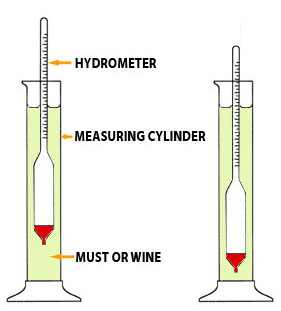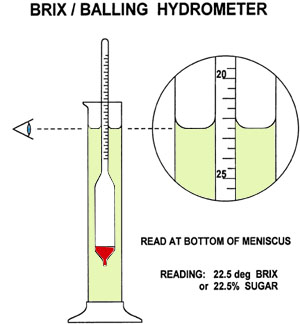The hydrometer is one of the most important tools a winemaker needs, so it's vital to learn how to use it correctly.
What Is A Hydrometer?
The hydrometer is an essential piece of testing equipment used by winemakers and brewers alike. It's usually made of blown glass, with a weighted, bulbous bottom and a long narrow stem, and is used in conjunction with a tall, thin measuring cylinder which contains the liquid. When placed into the sample in the cylinder, its design allows it to float in the liquid with the bulbous end downwards. A reading is then taken by looking at a scale, marked on the stem, where the surface of the liquid matches the scale.
What Does A Hydrometer Actually Do?
A hydrometer enables the winemaker to find the specific gravity or SG, (SG = is the ratio of the density of must or wine to the density of water). It therefore measures the amount of natural sugar in a must or wine. It allows winemakers to gauge and adjust their recipe depending upon the readings taken. A winemaker is also able to monitor the progress of fermentation and make immediate adjustments if necessary.
Anyone making wine knows that there is a direct correlation between the amount of sugar present in the grapes (or other fruit) and the ability to make wine.
Reasons why a winemaker might want to use a hydrometer:
- To measure the specific gravity (SG) of a must or wine
- To measure the amount of natural sugar present in a wine or must
- To estimate the potential alcohol percentage at time of chaptalising and yeast addition
- To enable accurate calculations to be made when increasing the alcohol percentage artificially
- To determine the progress of fermentation
- To calculate the percentage of alcohol conversion during fermentation by using the "before" and "after" readings
- To allow the winemaker to determine when fermentation has completed or at what stage it should be stopped
When you buy a hydrometer, take into account...
- The range of readings (highest to lowest), to make sure it will suit your situation. A standard range for home winemakers is 0.990 to 1.120. That is, in order to achieve a 12% wine, you'll want to start the fermentation of your wine at SG 1.090.
- What types of liquid the hydrometer measures. Some will only measure specific gravity, but most measure SG, potential alcohol (P.A.), and sugar content.
- The calibration temperature of the hydrometer. The most common calibration temp is 60° F.
- How to convert the SG readings based on the sample temperature.
[See VinoEnology to assist with calculations]. - Whether the sugar content scale is expressed in ounces per gallon (US/Imperial), or in grams per litre.
- If it is the right size to fit in your measuring cylinder.
- If it comes with a protective case - it should as they are very fragile.
How A Hydrometer Works
The best way to explain the working of an hydrometer is with a graphic example.
 Taking a sample
Taking a sample
A sample of must* is taken and poured into a measuring cylinder. The hydrometer is gently lowered into the cylinder with a gentle spinning motion. It will then bob up and down a little until it finds its level.
In the image are two hydrometers in measuring cylinders. The one on the left which sits higher up in the cylinder is showing a higher SG - meaning there is more sugar in it.
The one on the right is an example of a wine containing very little sugar. The sugar could be almost fully fermented out into alcohol at this stage, or it's a sample with a very low sugar level.
NB. Be careful not to drop the hydrometer into the measuring cylinder too hard as it could hit the bottom and break.
*must = unfermented grape juice
How to read a hydrometer

To take the reading here are a few easy to follow steps:
- Sterilize the hydrometer, wine thief, and measuring cylinder with sodium metabisulfate or some similar sterilant.
- Place the measuring cylinder on flat surface.
- With the wine thief, draw off a sample of must or wine - use clean samples that don't contain sediment or solid particles, as this will affect the readings.
- Fill the measuring cylinder with enough liquid to just float the hydrometer - usually about 80% full.
- Gently lower the hydrometer into the measuring cylinder; spin it as you release it, so no bubbles stick to the bottom of the hydrometer (this can also affect readings).
- Making sure the hydrometer is not touching the sides of the measuring cylinder and is floating freely, the take a reading across the bottom of the meniscus
Meniscus is the curve in the upper surface of a liquid close to a container. The reading should be read as something like: SG 1.030, and not shortened to SG 30 as this may cause confusion later on.
- Always thoroughly clean up your hydrometer, measuring cylinder and any other containers used.
- Get into the habit of taking and keeping good records of your readings. I guarantee that you will want to reference them at sometime!
Types of hydrometer
There are many different types of hydrometer, some only have one scale, some two and others three. The three measurements a winemaker requires from a hydrometer are: specific gravity (SG), sugar and potential alcohol.
The SG scale usually reads from 0.990 to 1.120. The S.G. of water is 1.000, therefore if you float your hydrometer in water (as described above), the surface should rest at the 1.000 mark. As you dissolve sugar in the water, the hydrometer will float higher.
Some weights for consideration
Always remember to double check measurements and calculations for accuracy. It may not be too critical to get everything completely correct for home wine making, but it's a good habit to get into in order to avoid too much or too little alcohol being produced by incorrect measurements.
One pound of sugar dissolved in one U.S. gallon¹ of water will give hydrometer reading around 1.046 ²
¹ One U.S. gallon = 128 fluid ounces, or 3.7853 liters, or 0.833 Imperial gallons
One Imperial gallon = 160 fluid ounces, or 4.5459 liters, or 1.2 U.S. gallons.
NB. 5 U.S. gallons = 4¹⁄6 Imperial gallons, and 5 Imperial gallons = 6 U.S. gallons.
² Note also that one pound of sugar dissolved in one gallon of water is not the same as one pound of sugar added to one gallon of water.
Different SG scales
Sugar can be measured in units, such as ounces per gallon (oz/gall), but there are several accurate measurement scales in use for quick reference. These are in different forms - in degrees Balling, Brix, Baumé or Oeschle - depending what part of the world you are in.
Balling is used mainly in South Africa, Oeschle in Germany and other parts of Europe, and Brix in most other parts of the world. It's your preference which one you wish to use.
See more hydrometers here...
More useful information at Jack Keller's site on Using Your Hydrometer



